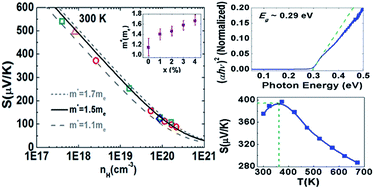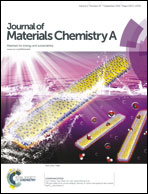Thermoelectric properties of Sn-doped p-type Cu3SbSe4: a compound with large effective mass and small band gap†
Abstract
Cu3SbSe4-based compounds composed of earth-abundant elements have been found to exhibit good thermoelectric performance at medium temperatures. High zT values were achieved in previous studies, but further insight into the transport mechanism as well as some key material parameters is still needed. In this work, we studied the electrical and thermal transport properties of Sn-doped Cu3SbSe4 between 300 K and 673 K. It was found that the single parabolic band model explains the electrical transport very well. Experimentally, we determined the band gap to be around 0.29 eV. The density-of-state effective mass was found to be about 1.5 me for the doped samples. The transport properties suggested degeneracy splitting near the valence band maximum that was not captured by previous band structure calculations. The maximum zT ∼ 0.70 was obtained at 673 K, and the optimized carrier density was ∼1.8 × 1020 cm−3, and the potential for further improvement of zT via material engineering is briefly discussed.


 Please wait while we load your content...
Please wait while we load your content...